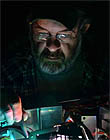|
|
This topic comprises 2 pages: 1 2
|
|
Author
|
Topic: Which anamorphic is better?
|
|
|
|
|
|
|
|
|
|
|
|
|
|
|
|
|
|
|
|
|
|
|
|
|
Steve Guttag
We forgot the crackers Gromit!!!

Posts: 12814
From: Annapolis, MD
Registered: Dec 1999
|
 posted 05-21-2005 02:52 PM
posted 05-21-2005 02:52 PM




An optical bench is a nice tool but it doesn't tell the whole story in film projection. The film is not stationary during projection. It is pumping in and out. It fact, it has been shown that the position of the film that we focus to is when it is most puckered. (High speed photography experiments were done to show this).
Both the ISCO Cinelux Ultra MC (later known as the Ultra MC) and the Schneider Cinelux anamorphic (compact) are 4-element anamorphics. I can believe that the Schneider has the edge on ISCO in the near field. It is a very good lens. However, watch out for Schneiders from before 1993 or so...they absolutely sucked...very piss-poor focus uniformity. Another issue even with current Schneiders is that they do not have a 2:1 expansion....they are a bit wide and it varies with the prime lens.
Then again, you are comparing Schneider's 1990s lens to an ISCO design that goes back to the 60s Kiptar designs.
Since the late 1980s ISCO had the ISCO Ultra Star Anamorphic MC lens, a 5-element that is significantly better than Schneiders in both focus uniformity and less distortion to the picture. In the late 1990s, ISCO brought out the Blue-Star anamorphics, a 6-element design that is just simply the best anamorphic lens, period. Less distortion, sharp corner-to-corner and no chromatic abberations. If you are working with Schneider anamorphics, you are working with 3rd best, at the most. ISCO has discontinued their Ultra anamorphic (why have 3 levels?).
I have used Blue Stars on short throws (22-feet) and long throws (110-feet) and they shine every time.
Where Schneider is doing better in anamorphics is on their "integrated" designs. ISCO is still using their old design, even when coupled to their newer Ultra Star PLUS (red) lens. Schneider has their compact anamorphic attach the same way as the full-sized models...they screw on (with close couplers, if necessary).
So, at this point, I would give the edge to Schneider on compact anamorphics and ISCO the lead on full-sized models. Compacts should only be used where absolutely necessary anyway, they are always an inferior design to a company's full-sized models. The compacts are handy for short focal lengths were vignetting could result on lens turrets. Schneider's ES models also gets the picture out of the lens without vignetting pretty darn well. The one exception to this rule is ISCO does have three ultra-short Blue-Star integrated anamorphics (down in the 45mm range).
| IP: Logged
|
|
|
|
|
|
|
|
All times are Central (GMT -6:00)
|
This topic comprises 2 pages: 1 2
|
Powered by Infopop Corporation
UBB.classicTM
6.3.1.2
The Film-Tech Forums are designed for various members related to the cinema industry to express their opinions, viewpoints and testimonials on various products, services and events based upon speculation, personal knowledge and factual information through use, therefore all views represented here allow no liability upon the publishers of this web site and the owners of said views assume no liability for any ill will resulting from these postings. The posts made here are for educational as well as entertainment purposes and as such anyone viewing this portion of the website must accept these views as statements of the author of that opinion
and agrees to release the authors from any and all liability.
|

 Home
Home
 Products
Products
 Store
Store
 Forum
Forum
 Warehouse
Warehouse
 Contact Us
Contact Us




 Printer-friendly view of this topic
Printer-friendly view of this topic







![[thumbsup]](graemlins/thumbsup.gif)




